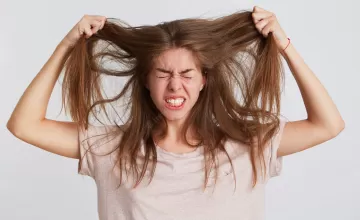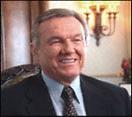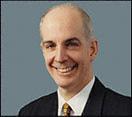Parsa Mohebi, M.D



Men and women who have the impulse to pull their own hair out may be suffering from trichotillomania. Trichotillomania is an impulse control disorder characterized by the repeated urge to and behavior of pulling out one's own hair. Impulse control disorders resemble substance addictions because the patient feels out of control of his or her own behaviors. Men and women with trichotillomania live relatively normal lives but typically show signs of hair loss, thinning, and bald spots all over the scalp and body from pulling it out.
Treating trichotillomaniagoes far beyond trying to stimulate hair regrowth.Even if Rogaineor laser therapy for hair losswere to regrow hair, there is a strong possibility that trichotillomania patients will continue to pull their hair out. Patients with trichotillomania therefore, should be treated at the source of the disorder in conjunction with using proven hair loss treatments.
In addition to medication, Habit Reversal Training (HRT) by a trained counselor has proven to be successful in treating trichotillomania. With Habit Reversal Training, the individual is taught to recognize and redirect their impulse to other more constructive activities. Often times, trichotillomaniapatients are asked to keep a journal of their hair pulling episodes. This can help the counselor and patient to identify and develop strategies to avoid situations that might trigger hair pulling episodes. Journals often include the location of the incident, number of hairs pulled, date, time, and their feelings and thoughts during the episode.
Treating a trichotillomania patient's baldness may be done simultaneously or after proper treatment of the disorder. Rogaine (minoxidil)can be a helpful aid to HRT by stimulating the follicles underneath the scalp, potentially facilitating or expediting hair growth.Treating a patient’s hair loss while they continue to pull their hair out is not constructive. Since this type of balding is not genetic due to the production of DHT, Propecia (finasteride)won't likely help.
Patients who've suffered from trichotillomania for awhile may damage or even remove the hair roots by excessive pulling, making non-surgical hair regrowth next to impossible. Surgicalhair restorationmay be an option for trichotillomania patients whose hair roots are too damaged to produce new hair on their own. Hairrestoration surgeryshould be reserved only for patients who've been successfully treated and no longer suffers from trichotillomania.
Catching and treating trichotillomania early will most likely reduce damage done to the hair follicles and eliminate the need for hair loss treatment, since undamaged hair will return on its own.

In the 80's hair restoration surgery as a hair loss solution evolved dramatically, as the large punch grafts were gradually replaced with a more refined combination of mini and micrografts. This "combination mini micrografting" hair transplantation procedure no longer used the punch to extract the bald resistant grafts. Rather a strip of bald resistant hair was surgically removed from the back of the head and then trimmed into mini and micrografts.
Typically the minigrafts (4-8 hairs) were used to create fullness and density, while the one, two, and three hair micrografts were used to create a refined and feathered hairline in front. This combination procedure also normally used more grafts, several hundred grafts per session, rather than the approximately 50 to 200 large grafts of the original punch graft procedure.

The 90's saw the gradual introduction of a very refined surgical procedure hair loss solution now known as "follicular unit hair transplantation" or "FUT". This exacting and labor intensive procedure transplants hairs in their naturally occurring one, two, three, and four hair "follicular unit groupings" in which they grow naturally.
To create such natural follicular unit grafts, which mimic the way hair grows naturally, typically requires the use of high powered magnification. Such magnification enables the surgical technicians to properly visualize the follicular units in the donor tissue. They are then able to isolate them and cut them into 1, 2, 3, and some times 4 hair follicular unit grafts.
Critical to the ultimate success of the follicular unit hair transplant procedure was the introduction of the binocular microscope by Dr. Bobby Limmer of San Antonio Texas in the late 1980's. Dr. Limmer found that by using the microscope he and his staff were able to successfully isolate and trim the naturally occurring follicular units into individual grafts.
For his part in pioneering the use the microscope in graft dissection and the follicular unit procedure Dr. Bobby Limmer was awarded the "Platinum Follicle Award" by the International Society of Hair Restoration Surgery in 1996. Many physicians now fondly refer to him as the "Godfather of Follicular Unit Hair Transplantation".


While Dr. Limmer pioneered the use of the microscope in trimming follicular unit grafts, it was Dr. Robert M. Bernstein, in collaboration with Dr. Bill Rassman, who pioneered and advanced the concept of large sessions of all follicular unit grafting. These large follicular unit sessions enabled patients to achieve both naturalness and density.
Dr. Bernstein, who coined the name "follicular unit hair transplantation", tirelessly advocated for its adoption in ground breaking articles and lectures that are today recognized as benchmarks in the advancement of this procedure. Click to read these ground breaking hair restoration articles and papers.
In recognition of his many contributions in both conceptualizing, pioneering and advocating "follicular unit hair transplantation", Dr. Bob Bernstein was awarded the "Platinum Follicle Award" by the International Society of Hair Restoration Surgery.
Over time the merits of this refined but difficult to perform procedure became accepted and the follicular unit hair transplant procedure has become acknowledged by most hair restoration physicians to be the "Gold Standard" for surgical hair restoration. Click here to see video of a Follicular Unit Hair Transplant procedure.
Some feel that hair restoration surgery has evolved to its highest degree now that it relocates hair exactly as it grows naturally. However, even the "Gold Standard" in hair transplantation has continued to evolve by becoming even more "ultra refined".
Today some leading hair restoration surgeons, including all members of the Coalition of Independent Hair Restoration Physicians, perform an ultra refined follicular unit hair transplant procedure using very tiny incisions that enable them to safely "dense pack" tiny grafts when appropriate. This ultra refined follicular unit procedure is a hair loss solution that enables patients to achieve cosmetic density in a given area after only one surgical session.

One of the more popular hair loss products on the market today for those with thinning hair is Provillus. Available for both men and women, making promises to “re-grow beautiful healthy hair”, this product consists of a topical and oral solution with an FDA approved hair regrowth ingredient and a number of conjectured “all-natural” dihydrotestosterone (DHT) blockers.
Other ingredients that promote a healthy scalp and head of hair are also contained in this product. The theory behind Provillus is to revive the hair follicles with growth stimulators and attack hair loss at its source by blocking DHT.
In order to fully evaluate the efficacy of this product, we must further explore each ingredient to determine whether or not this hair loss treatment delivers what it promises. Below you will find a list of ingredients and information that will help you determine whether or not Provillus is right for you.
Minoxidil (found in Rogaine, Xandrox and other solutions) is an FDA approved hair growth treatment and many balding men and women use it with great success. This particular ingredient is what allows Provillus to advertise their product as FDA approved.
Azelaic acid has been found to clean the skin and potentially inhibit DHT, the hormone responsible for androgenic alopecia.
Combining these two “forces” therefore in theory, may be a more powerful treatment than minoxidil alone. However, no clinical studies have been performed on azelaic acid as a standalone product therefore, whether or not it can stop hair loss is purely conjecture.
The Provillus oral solution contains a number of supposed DHT blockers including saw palmetto for hair loss, Vitamin B6 and Zinc, pumpkin or cucurbita maxima, and nettle root. Because evidence exists that these ingredients may be an effective treatment for benign prostatic hypertrophy (BPH), theories have been produced that they might also effectively treat baldness. Though we can appreciate the aspiration for balding men and women to use herbal products as an “all-natural” replacement for Propecia (finasteride), the problem we have is that most of them only contain anecdotal if any evidence at all that they can successfully treat baldness.
Provillus oral solution also contains a number of components that are said to promote healthy hair growth and cleanse the scalp. These include eleuthero, uva-ursi, muria puama, horsetail, para-aminobenzoid acid (PABA), and magnesium. Understand however, that promoting a healthy scalp and hair is not the same as stimulating newhair growth and hair regrowth, nor does it signify an effective hair loss treatment.
The only side effect that we could find listed on the Provillus website is an upset stomach. It is reported that taking it with food often stops this. Be sure to follow the links to the ingredients listed above as many of them also have potentially reported side effects. Consulting with a physician before taking any herbal hair loss medication is advised.
Currently there are no standards on dosages of herbal medications in the United States. In addition, no formal clinical studies have been performed on them for treating baldness. Therefore, the suggested daily value listed on the ingredient package is based on something other than government regulation and scientific study.
A one month supply of Provillus topical and oral supplement for men or for women costs about $50 per month. Discounted prices are available when bought in bulk.
For the cost of Provillus, one can purchase generic finasteride and generic minoxidil which are FDA approved hair loss treatments for safety and efficacy.
Given that Provillus topical treatment contains FDA approved hair regrowth ingredient minoxidil; we can at least agree that it may have some marginal benefit for men and women suffering from androgenic alopecia. However, due to the lack of compelling evidence in these other conjectured hair loss solutions, it may be more beneficial and cost effective to spend your money on Propecia (finasteride)for men only and Rogaine (minoxidil) that has helped balding men and women worldwide.

 Is this hair loss treatment effective?
Is this hair loss treatment effective?Extreme Hair Therapy (EXT) for thinning hair is a 5 "step" hair loss treatment solution created by Hair Club that claims not only to rejuvenate your hair, but "rejuvenate your life". Making claims to be FDA approved, EXT claims to stimulate hair regrowth in thinning areas by keeping hair in the anagen (hair growth) phase longer.
Balding men and women seeking hair loss solutions should be careful to do their due diligence in researching all products they are considering. Is this one of the hair loss products that really works to treat baldness? Can Extreme Hair Therapy really deliver what it promises?
Below we take a look at each of the 5 “steps” and separate treatments and analyze whether or not EXT can remedy alopecia in men and women.
Step One: Moisturizing or Revitalizing Cleanser
This moisturizing shampoo is rich with vitamins and works to cleanse the scalp. Though it claims to revitalize and strengthen thinning hair, the ingredients are not listed on their website. Many hair rejuvenators and thickening agents (commonly referred to as volumizing shampoos) help to make hair appear thicker as they take on hydration and swell. Unfortunately, these thickening agents do nothing to stop the progression of male pattern baldness, even if it temporarily makes the hair shaft appear fatter.
Step Two: Enzyme Scalp Cleanser
Claiming to be a “new breakthrough”, this organic formula removes sebum oils that can sometimes hinder hair growth. Though sebum buildup, excessive dandruff, and scalp dermatitis are sometimes responsible for certain non-genetic types of balding such as diffuse alopecia or telogen effluvium, it does not promote androgenic alopecia (hereditary male or female hair loss).
Step Three: Energizing Conditioner
Adding nutrients such as proteins and wheat amino acids, this conditioner helps to promote a healthy scalp and hair growth. It should be noted that nothing in this step claims to stop hair loss or stimulate hair regrowth.
Step Four: Hair Revitalizing Complex
This dietary supplement containing Vitamins B3, D, and E, Biotin, saw palmetto and nettle root is taken twice daily, once in the morning and once at night. Some of these ingredients can also be found in several other hair loss products such as Provillus, Procerin, and Avacor.
Though some of these ingredients work to treat benign prostatic hyperplasis (BPH) in men by inhibiting DHT (the hormone responsible for female and male pattern baldness), no formal clinical studies have been performed on successful hair loss treatment. It should be noted that tocotrienol molecules in Vitamin E may effectively treat alopecia but its counterpart tocopherol (commonly found in alternative herbal hair loss treatments such as HairMax MD), is not supported. Additionally, because there are no regulations on herbal medications in the United States, the daily recommended value and dosage in Extreme Hair Therapy is based on something other than FDA regulation.
Step Five: Minoxidil (2% or 5%)
Minoxidil (the active ingredient in Rogaine and Xandrox) is an FDA approved hair regrowth formula and is used by many balding men and women with great success. Because Extreme Hair Therapy includes this, they are legally allowed to claim it to be FDA approved.
Unfortunately, this information is not available on the Hair Club website. Upon calling the toll free number for this information, we are told that we must schedule a consultation with a Hair Club specialist. Customer service representatives are apparently not provided with this information.
No EXT side effects are reported on the Hair Club website however, Minoxidil may cause scalp irritation or redness, chest pain, a rapid heartbeat, faintness, swelling of the hands and/or feet, and unwanted facial hair growth. Be sure to discuss the use of herbal medication with your physician before taking them. Saw Palmetto should be avoided by pregnant women with hair loss.
The only FDA proven ingredient in Hair Club’s Extreme Hair Therapy hair loss treatment is Minoxidil. Though Saw Palmettoand nettle root may be effective in treating men with an enlarged prostate by inhibiting DHT, no formal tests have been performed on them.

 Crinagen is an all natural alcohol-free topical scalp spray clinically backed to reduce the amount of DHT (dehydrotestosterone) in the scalp. It contains no alcohol, and has displayed no side effects. Crinagen is also equally safe for men and women and is most effective in men and women with thinning hair. In addition to blocking scalp DHT, they both are reported nourish the scalp’s hair follicles. Crinagen usually displays its effects on average in five months.
Crinagen is an all natural alcohol-free topical scalp spray clinically backed to reduce the amount of DHT (dehydrotestosterone) in the scalp. It contains no alcohol, and has displayed no side effects. Crinagen is also equally safe for men and women and is most effective in men and women with thinning hair. In addition to blocking scalp DHT, they both are reported nourish the scalp’s hair follicles. Crinagen usually displays its effects on average in five months.
The product's main ingredients are Saw Palmetto, Zinc, and Azelaic Acid. All 3 ingredients are reported to reduce the production of scalp DHT and nourish the scalp's hair follicles.
Crinagen has not been clinically proven nor approved by the FDA. Thus, like Revivogen and Tricomin, Crinagen should be used only after seriously considering proven treatments like Propecia (finasteride) and Rogaine (minoxidil).
Don't expect immediate results. It's recommended to use Crinagen for at least 6 to 12 months before determining its effectiveness. Documenting your progress with bi-monthly photos can help you determine whether or not Crinagen is working for you.
Hair shedding is a common symptom the first few months and a sign that the medication may be working for you. It's crucial to push past this stage with continued use for the recommended period of time.
To date, only surgical hair restoration is proven to grow hair in completely bald areas. You are invited to have a free virtual consultation with one of our prescreened hair restoration physicians.

 Is it Effective in Treating Baldness?
Is it Effective in Treating Baldness?Hair loss suffering men and women are always seeking new and credible treatments and with good reason. Medical science is still years from producing a true hair loss cure and current treatment options are vastly limited. Women with hair loss have even fewer options than their balding male counterparts when it comes to proven, non-surgical hair loss treatments. Additionally, there is no shortage of cunning charlatans waiting to take advantage of the unwary consumer. Thus, when a new product like Kevis Hair Rejuvenation Formula comes along claiming to be a “permanent” solution and “the most successful and potent hair loss treatment on the planet”, potential customers would be wise to remain skeptical.
Kevis hair loss treatment is not an entirely new solution. In fact, their website states that it has been sold throughout Europe and Asia for over 25 years but has only been available in the United States for 15 years. This is simply the 8th generation of the formula; hence their new name Kevis 8. But how can such an impressive treatment exist for 10 years yet remain virtually unknown to roughly 70 million balding American men and women? What’s even more surprising is that Kevis claims that published clinical studies give this solution for baldness an average success rate of 92%. So why are so many people still seeking viable hair loss treatments today?
Kevis 8 is a drug-free topical lotion developed and manufactured by Italian pharmaceutical company, Farmaka, and distributed by Kevis Rejuvenation Programs in North and South America and by Pfizer in Europe and Asia. As such, it does not come under the regulatory supervision of the United States Food and Drug Administration (FDA). It is applied directly to the scalp and can be used by both men and women. Ingredients are listed as:
Water, SD Alcohol 40-c+SD Alcohol 3-c, Propylene Glycol, Hydrolized Glycosaminoglycans (Thioglycoran), Panthenol, Sorbic Acid, Methylparaben, Hyaluronic Acid (H.U.C.P.), Thurfylnicotinate HCL, Propylparaben, Sodium Hydroxide, Biotin, Fragrance.
H.U.C.P is a high concentrate of pharmaceutical grade hyaluronic acid which purportedly aids in the breakdown of accumulated DHT in the follicle and creates a binding effect in the follicle's receptor sites preventing further DHT buildup. Kevis also lists the ingredient Tricozyme™. Tricozyme is a protein enzyme that they claim attaches itself to free-floating DHT molecules rendering them “inactive and inoperable”.
Kevis claims that results from using their product are “permanent”. Once hair follicles are protected from the effects of DHT they will remain DHT resistant for life. Thus, their claim is that once the desired result is reached, there is no need to continue using Kevis. This is a hefty claim considering all other non-surgical balding solutions are required to be used for life in order to experienced continued benefits.
In an effort to demonstrate its efficacy, Kevis provides complete, downloadable copies of seven clinical studies conducted by various institutions in France and Italy and provides summaries of each. They also offer several before and after photos (including those of company founder and President Brian Reichenberg) and written testimonials. What seem to be conspicuously missing are references to third-party studies and publications in peer reviewed journals. Without these critical components it’s impossible to verify the company’s hair growth claims.
Balding men and women may want to stick with clinically proven and FDA approved medical hair loss treatments. For men those treatments are Rogaine (minoxidil) and Propecia (finasteride). Rogaine is also approved for use by females. However, women should not ingest or even come in contact with finasteride due to the risk of specific birth defects. Men and women who are unable or unwilling to use these drugs can find credible alternatives.
When it comes to purchasing and using hair loss treatments, there is much more at stake than your hard earned money. Dedicating months or years to ineffective treatments may result in the unnecessary loss of valuable and irreplaceable hair follicles.

In women with PCOS(polycystic ovarian syndrome), high levels of androgens (male hormones) in the body may cause hair loss. DHT (dihydrotestosterone), more abundant in men, is created from a combination of testosterone and5-alpha-reductase enzymes. DHT can bind to hair follicle sites, accelerate the natural hair growth cycle, and cause hair to go into resting (catagen) sooner causing thinning hair with each cycle.
Women with PCOS are more susceptible to androgenic alopecia, more commonly referred to as male pattern baldness or genetic female hair loss. Androgenic alopecia is also the number one cause of hair loss and thinning hair in the world.Women with androgenic alopecia typically lose hair in a pattern similar to the ludwig scale,and less commonly the norwood scale.
If you suspect you have PCOS, you should consult with a physician and get tested for it. Only a physician can diagnose you and recommend a proper treatment.


Today it is a very refined outpatient procedure that can produce full and natural looking results, even after only one hair transplant session.
When performed correctly not even a hair stylist will detect that a person has had a hair transplant.
However, to achieve such natural results it is critical that the hair transplant procedure be "performed correctly". To do so requires a hair restoration clinic that can perform a follicular unit hair transplant at the highest levels of skill, experience, and dedication.
A great hair transplant is the result of using a state of the art surgical procedure and performing it with great skill and artistry. Today the acknowledged "gold standard" in hair transplant surgery is called "Ultra Refined Follicular Unit Hair Transplantation".
This relatively new hair transplant procedure enables a patient to achieve extremely natural results because it recreates and mimics the way a person's hair grows naturally, hair for hair.

To understand this procedure you must first understand how hair grows naturally.
If you look closely at naturally growing hair using magnification you will see that hair actually grows in groupings of one, two, three, and four hairs.
These naturally occurring hair groupings grow in irregular patterns on the scalp similar to trees growing in the forest. These groupings are technically referred to as "follicular units".
By relocating these carefully prepared and isolated follicular units, physicians doing "follicular unit hair transplantation" recreate a natural pattern of hair in the balding areas.
To do this properly is a very time consuming process. It requires a team of skilled and meticulous medical technicians working closely with the lead physician.
All our physician members perform this hair transplant procedure with excellent results. They are granted membership in the Coalition of Independent Hair Restoration Physicians strictly based on their proven high level of experience, ethics, and skill in successfully performing this patient friendly procedure.
While the follicular unit procedure is more demanding upon the medical staff, it produces dramatic and life long advantages for the patient such as undetectable naturalness, rapid healing, and optimal use of their limited donor hair.
Only a minority of hair transplant surgeons are committed to doing the follicular unit procedure properly. Many physicians continue to dissect grafts without regard to the integrity of the follicular units. Follicular units are often transected and damaged as donor tissue is cut to conform to the size of the recipient holes rather than to maintain the integrity of the follicular units.
Such common standard hair transplant procedures are quicker and simpler to perform than follicular unit hair transplantation from the hair transplant surgeon's perspective. The standard hair transplant procedure is also often more profitable for the clinic since it requires less staff time, training, resources, and skill. However, the results are generally suboptimal for the patient.

Each follicular unit is surrounded by small glands, blood vessels, nerves, and a connective tissue sac making it a tiny self contained unit.
If these follicular units are damaged during removal or dissection, the hair may grow poorly.
Therefore it is important to cut only in the loose tissue between the follicular units to keep each follicular unit intact and avoid damaging it.

Over the past several years surgeons have used various techniques to perform follicular unit hair transplantation. One such technique is the Lateral Slit Technique, also known as Coronal or Perpendicular Grafting. This technique’s name is derived from the angle and direction in which the graft incisions are made.
While there are other techniques for performing densely packed and highly refined follicular unit transplantation, the lateral slit technique offers a high degree of control over the angle and direction in which the transplanted hairs will ultimately grow.

The lateral slit technique has been used both intuitively and systematically for years by hair restoration physicians. However, it has recently gained popularity as a systematic and precise way of performing follicular unit hair transplantation.
Many of our physician members use the Lateral Slit Technique exclusively or in combination with other techniques for creating graft incisions. The lateral slit technique enables a surgeon to create graft incisions at varying angles (ranging from 10 to 90 degrees to the scalp), including very acute angles that will make the transplanted hair grow out lying flatter to the scalp. The ability to create incisions at very acute angles is particularly useful in areas such as the front temples and sides where the hair normally grows out lying flat on the scalp.

The lateral slit technique also helps enable a surgeon to determine the direction of the graft incisions. This then determines the ultimate direction of the transplanted hairs growth. Thus a surgeon can use this technique to control and vary both the direction and angle at which the transplanted hair will grow in order to mimic the subtle changes in hair direction that occur naturally.
Each graft incision is created by analyzing the neighboring hair so the surgeon can reproduce the correct hair pattern. As a result, as each transplanted hair emerges from the scalp it will grow and lay in a similar direction as its neighboring non-transplanted hairs.
Lateral slit incisions also tend to be more parallel to the scalp and thus more superficial and less invasive to the scalp’s underlying vascular structure. This parallel alignment also enables a physician to place more grafts per square centimeter with out the grafts compressing or popping up since the pressure exerted on the grafts does not push them upward from the scalp.
Some of our members use custom blade cutters to create tiny blades to make incisions that match the size and depth of each follicular unit graft being transplanted. This enables a surgeon to safely dense pack more grafts into a given area during a surgical session. Healing time is also more rapid, with minimal scarring.

Typically most clinic’s blades range from 1.5mm to 2mm in size. However, by using the custom blade cutter our physicians can create blades as small as .7mm for a single hair graft and .9mm for a multi hair graft.
In addition, the blades created by the custom cutter are squared off to match the shape of the bulb end of a hair follicle. Non custom cut blades are typically spear pointed which requires them to be inserted deeper thus causing more trauma to the scalps vascular structure.
The ability to control the depth of the incision each blade makes is also critical. Each blade is placed in a blade holder that is set to not allow the blade to go any deeper than required for the graft to being placed in the incision. This minimizes unnecessary trauma to the deep vasculature of the scalp, thus enabling close tight incisions, minimal tissue swelling, and quick healing that leaves no visible scaring, pitting, or cobble stoning of the scalp.
The plane and direction in which each follicular unit graft is placed on the scalp can also impact the ultimate appearance of density that can be produced with a given number of grafts. This is because hairs within a follicular unit are typically next to each other inline.
Therefore by arranging each multiple hair graft on the scalp in a linear fashion to the line of sight, each follicular unit will provide the maximum appearance of fullness and scalp coverage. This also mimics how hair is normally aligned on the scalp.
Special thanks to Dr. DeYarman, Dr. Sharon Keene, Dr. Jerry Cooley, Dr. Alexander, and Dr. Glenn Charles for contributing their expertise and photos for this section.